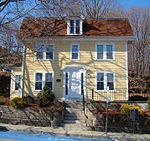Roman Catholic Diocese of Norwich

The Diocese of Norwich (Latin: Diœcesis Norvicensis) is a Latin Church ecclesiastical territory or diocese of the Catholic Church in Connecticut and a small part of New York. It was created on August 6, 1953, by Pope Pius XII. Its canonical territory consists of the Connecticut counties of Middlesex, New London, Windham and Tolland. It also includes Fishers Island in New York. The Diocese of Norwich is one of three Roman Catholic Dioceses in the United States to have territory in more than one state, the others being the Diocese of Gallup and the Diocese of Wilmington. (The Washington archdiocese has DC and 5 Maryland counties.) From 1781, Lebanon, just northwest of Norwich, is the place in which the Catholic "Mass was first celebrated, continuously and for a long period, within the limits of the State of Connecticut."
Excerpt from the Wikipedia article Roman Catholic Diocese of Norwich (License: CC BY-SA 3.0, Authors, Images).Roman Catholic Diocese of Norwich
Broadway, Norwich
Geographical coordinates (GPS) Address Nearby Places Show on map
Geographical coordinates (GPS)
| Latitude | Longitude |
|---|---|
| N 41.530555555556 ° | E -72.077222222222 ° |
Address
Broadway 197
06360 Norwich
Connecticut, United States
Open on Google Maps










